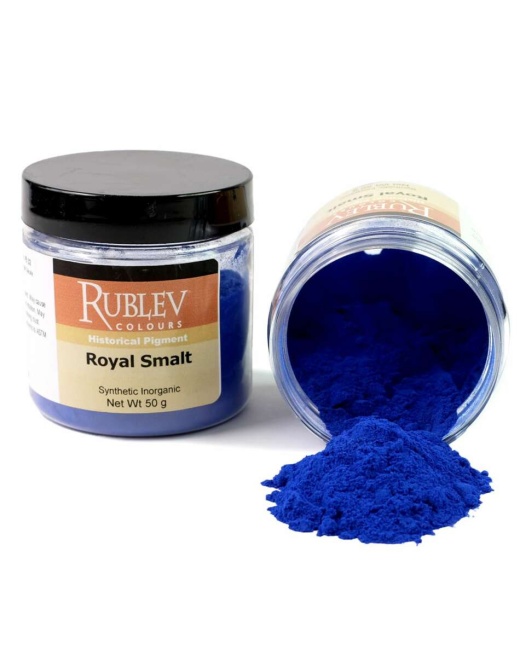Royal Smalt is a coarsely ground potassium glass of blue color. Its deep blue color is due to the greater amount of cobalt added during manufacture and coarser grind than standard smalt.
| Pigment Names | |||||||
| Common Names: | English: smalt French: smalt German: Smalte Italian: azzurro di smalto, smaltino Japanese: hana konjo Spanish: esmalte | ||||||
| Synonyms: | English: starch blue French: émail, esmail, azur à poudrer, bleu d'émail German: Kaiserblau, Königsblau, Azurblau, Sächsischblau, Streublau, Couleur, Eschel | ||||||
| Nomenclature: |
| ||||||
| Pigment Information | |
| Color: | Blue |
| Pigment Classification: | Synthetic Inorganic |
| Colour Index: | Pigment Blue 32 (77365) |
| Chemical Name: | Potassium Cobalt Silicate |
| Chemical Formula: | CoO•K•Si |
| CAS No.: | Not Listed |
| Series No.: | 7 |
| ASTM Lightfastness | |
| Acrylic: | Not Listed |
| Oil: | Not Listed |
| Watercolor: | Not Listed |
| Physical Properties | |
| Particle Size (mean): | 40 microns |
| Density: | 6.11 g/cm3 |
| Hardness: | – |
| Refractive Index: | 1.48–1.55 |
| Oil Absorption: | 25 grams oil / 100 grams pigment |
| Health and Safety | No acute or known chronic health hazards are associated with this product's anticipated use (most chemicals are not thoroughly tested for chronic toxicity). Protect yourself against potentially unknown chronic hazards of this and other chemical products by keeping them out of your body. Do this by avoiding ingestion, excessive skin contact, and inhaling spraying mists, sanding dust, and vapors from heating. Conforms to ASTM D-4236. |
For a detailed explanation of the terms in the table above, please visit .
Many colors can be made from cobalt, but smalt was the only pigment from it before the element was isolated in the 18th century. Smalt was an important pigment in European oil painting, particularly in the sixteenth and seventeenth centuries. Its origins probably lie in the blue pigment used by the ancient Egyptians, known as "Egyptian blue." Both pigments are made from glass that has been colored blue, and both are also used as glazes on ceramics.
SourceCobalt ore was heated to form an oxide mixed with silica and, under the name saffre or zaffre, was then sold to glass-makers who fused it with potash to form smalt. Numerous early recipes for the preparation of smalt are known; they all mention mixing saffre, silica, and potash, placing the mixture in a glass furnace where they were left for twelve hours, and stirring at intervals. The vitrified mass was later plunged into the water to make it friable so that it could be ground, sieved, and washed. It was marked according to color grade, the best being a deep violet-blue and the cheapest a pale sky-blue.
Permanence and CompatibilityBeing a glass, smalt is transparent. Its particles are vitreous, meaning that they have highly reflective surfaces. As smalt particles are ground finer, the surfaces are broken and fractured, increasing their light scattering effect and lowering their color saturation. For this reason, smalt cannot be ground as finely as many other pigments, so it must be used rather coarsely in paint.
Due to its low refractive index, smalt's color is more opaque when used in water-borne mediums and lime (fresco). In oil media, a dull color may be obtained because smalt's refractive index is close to that of dried oil.
Smalt is known to fade in paintings, but the degree to which this occurs varies even within the same painting. The reason for the fading has only been understood quite recently. Some assumed that the fading resulted from leaching out of the cobalt. However, Professor Jaap J. Boon and his collaborators recently found that the potassium concentration is crucial to fading. The color does not fade when the ratio of potassium to cobalt is 1:1 or higher.
Potassium is strongly alkaline, and their findings suggest a certain alkalinity level is required to maintain smalt's blue color. Drying oil creates a slightly acidic environment. The small proportion of fatty acids in the oil may react with the potassium. Moisture must be present for this reaction to occur, but potassium is known to attract moisture, and there will be occasions when the amount of moisture in the air is likely to be high.
The conclusion is that smalt made with a higher proportion of potassium to cobalt will not fade. Rublev Colours Smalt and Royal Smalt have a ratio of potassium to cobalt of 2.09: 1.00.
To further protect against discoloration and enhance its color, it is best mixed with lead white. The tradition was to sprinkle the smalt over a fresh paint layer to prevent discoloration and then dust off the superfluous pigment. Smalt exerts a powerful siccative effect on oils and was often used for this purpose alone.
Oil Absorption and GrindingSmalt absorbs a moderate amount of oil (25 g oil per 100 g of pigment). The pigment is refractory and difficult to wet, making mixing it with oil into a smooth paste difficult. Adding a small amount of bleached beeswax or aluminum stearate to the oil is best before mixing it with smalt. Allowing the oil and pigment mixture to "sweat" or stand overnight before further grinding with a muller often helps.
ToxicitySmalt contains cobalt, which can be toxic if inhaled or ingested. Therefore, care should be taken when handling the dry powder pigment to avoid inhaling the dust.
For more information on handling pigments safely, please visit .
